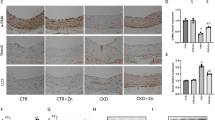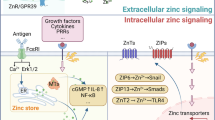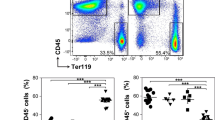Abstract
ABSTRACT: Male weaning rats were pair-fed a low-zinc diet or a controt diet. After 10 d, the animals fed the low-zinc diet showed physiologic signs of deficiency; however, they showed no clinical symptoms. Their estimated whole body zinc was 25 μtmol versus 39 μmol for the controls. The 65Zn absorption increased 2-fold and the tissue distribution altered: muscle and erythrocytes contained more, small intestine and liver less activity at 0.5 h postdose. in vitro, the erythrocyte 65Zn uptake rate increased also. The 65Zn uptake experiments required small quantities of erythrocytes. The difference observed between the deficient and control cells was significant and showed little overlap. The increase of the 65Zn uptake from a medium was not affected when the animals underwent endotoxn exposure 24 h before, as was reported to occur in whole blood 65Zn uptake. Therefore, we suggest the in vitro erythrocyte 65Zn uptake, performed in a standardized, near physiologic medium, to detect early, subclinical zinc deficiency.
Similar content being viewed by others
Log in or create a free account to read this content
Gain free access to this article, as well as selected content from this journal and more on nature.com
or
Author information
Authors and Affiliations
Rights and permissions
About this article
Cite this article
Van Wouwe, J., Veldhuizen, M., De Goeij, J. et al. Laboratory Assessment of Early Dietary, Subclinical Zinc Deficiency: A Model Study on Weaning Rats. Pediatr Res 29, 391–395 (1991). https://doi.org/10.1203/00006450-199104000-00012
Received:
Accepted:
Issue date:
DOI: https://doi.org/10.1203/00006450-199104000-00012
This article is cited by
-
Diagnostik des Zinkmangels
Zeitschrift für Gerontologie und Geriatrie (1999)
-
Clinical and laboratory assessment of zinc deficiency in Dutch children
Biological Trace Element Research (1995)
-
The role of the pancreas in the regulation of zinc status
Biological Trace Element Research (1994)
-
Dietary subacute zinc deficiency and potassium metabolism
Biological Trace Element Research (1994)



